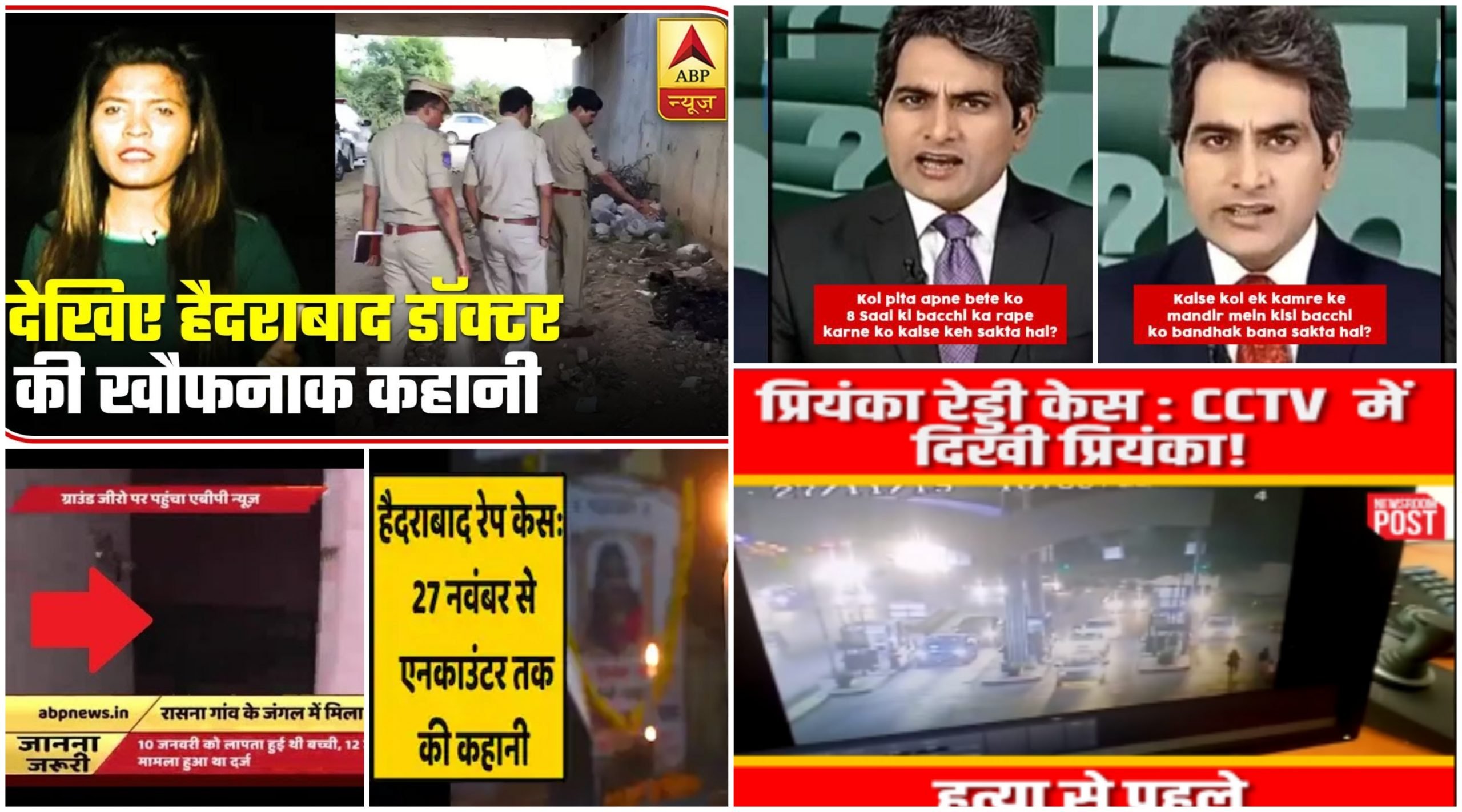Trigger Warning: Sexual Violence, Trauma, Rape
The Indian economy and state underwent a profound shift in the 1990s when the Indian Government liberalised its market by relaxing trade regulations and reducing tariffs. In this process, the relationship between the state and citizen also underwent a transformation. Citizens in this new era were encouraged to shed their passivity as recipients of welfare and actively participate in the market as consumers. It was during this period that privatised television news revolutionised the field of information broadcasting by recasting ‘news’ as a commodity. The purpose of delivering news was no longer limited to simply providing information—it was simultaneously also designed to provoke and excite audience members.
Gradually, television news started competing with TV serials and reality shows to garner viewers. The ‘breaking news’ culture and its accompanying visuals and suspenseful music, attempted to replicate the thrill and excitement found in cinema. In this context, reports on matters of sexual harassment and violence have become mostly sensationalist, leaving little to no space for nuance.
(Re)Casting Perpetrators of Sexual Violence as Exceptional to The Rule
‘Will Ram Sena Pay For It?,’ read the news headline on 26th January 2009 on Times Now a few days after several women were molested by men associated with the Shri Ram Sena at a pub in Mangalore. The Sena members argued that the action was provoked by young women in pubs, who they argued were bringing shame to the traditional Hindu/Indian ways of life by drinking alcohol and socialising with men. They further added that if these morally corrupt women were not corrected, India will not progress.
The debate on Times Now was hosted by Arnab Goswami, the channel’s star anchor at the time, who had invited multiple BJP and Congress politicians to discuss the Karnataka government’s alleged inaction to bring the perpetrators to justice. As the channel played the CCTV footage of the incident unfolding in ‘real-time’ on the screen, Renuka Chowdhury, the then Minister of Women and Development argued that the incident indicates the “Talibanization of India”.
Her statement, as scholar Swati Bandi mentions in her work, attempted to erase the Hindu-ness of Shri Ram Sena by recasting its members as backward, unmodern, and alien. Others criticised these men who entered the pub screaming bharat mata ki jai as outliers who do not represent ‘real Hindus’. There was a concerted attempt made by journalists and politicians to distance their patriotism and anxieties pertaining to female sexuality from those of the members of the Shri Ram Sena.
The fetishistic quality attached to recreations of sexual violence on TV, CCTV recording of crimes unfolding in real-time or sting operations makes for TRP-inducing news. In such a context the commitment to exploring the real causes underlying an act of sexual violence is non-existent.
Mr. Rajeev Pratap Rudy of the BJP, a Hindu nationalist party, condemned the act as being “disgusting”, “horrendous” and “unacceptable”, something that cannot be permissible in a “civilised society”. He further added that his daughter or sister could have been one of the women beaten by the members of the Sena and therefore, anyone who commits such an act should be punished. The appeal to the family man’s conscience to rise in rage in the face of violence against women is a common strategy used by commentators on television.
The purpose of evoking such sentiments is to both sensationalise an act of crime as well as distinguish between ‘good Hindu male control’ from ‘brutish, backward male control’, inspired by an alien culture. Such a formulation is misleading because it fails to critique the nationalist point of view that perceives women as repositories of family and by extension national honor. This lack of critique against gendered articulations of nationalism and national pride reinforces rape culture that enables crimes against women to take place.
While reporting on the Kathua rape case also, a similar attempt was made by de-politicise the violent sexual act in order to distance oneself from the perpetrators belonging to the dominant Hindu community and the BJP MPs supporting them. Arnab Goswami, who had by now left Times Now and started his own television channel called Republic TV, screamed at the representative of the Hindu Ekta Manch for supporting the Hindu rapists on his prime-time show. He asked the panelists in his booming voice, why is it that the rape of an eight-year-old is being given a communal angle, when the rape actually occurred due to a land dispute. His voice further to announce that he is a proud Hindu who openly condemns the rapists of a young child.
In Republic TV’s world-view, Asifa’s rapists were lustful, brutish men who committed the violent act simply to gain access to a piece of land. Their religion, therefore, had nothing to do with the crime. The fact that rape is frequently used as an instrument of intimidation by members of a dominant community to intimidate members of minority religious and caste communities is completely ignored. The needs of survivors of sexual violence are rendered secondary to preserving an unsullied image of the dominant Hindu caste community. Television news anchors like Arnab Goswami view rape mostly as an aberration than as a result of systemic oppression of women, in general, and Dalit, Adivasi and Muslim women, in particular.
Aestheticizing Sexual Violence On Television
As opposed to the state-monopolised satellite television that reached people’s homes in the form of Doordarshan, the New Media of the 1990s had abandoned the modest ethos of public service by embracing the free market. The brightly-lit studios and glamorous news anchors worked together to not only deliver the news but to excite and provoke. News in the post-1990s era was no longer an entity that got delivered by a neutral-sounding news anchor. It was a commodity that had to be actively sold by privately employed TV journalists. Eye-catching headlines, dramatic background music, and the ‘feeling journalist’ were essential to the stories that news channels attempted to sell to their audiences. Soon the ‘feeling journalist’ got replaced by the ‘self-righteous, angry journalist’ of the present times.
In such a context, issues pertaining to violence against women seldom make it to prime-time news hour and are usually relegated to late-night news segments. Sansani, is one such news segment run by ABP news that deploys dramatic sounding anchors and music to report ‘dangerous stories’ from India’s dark underbelly. Problematic recreation of real-life incidents narrated through the eyes of a male journalist is supposed to both titillate the audience as well as make them aware.
Sansani is also infamous for its particularly misogynistic patterns of reporting. Its news coverage excessively relies on the virgin/whore binary and its journalists frequently accuse women of filing false rape cases against men. Such a pattern, however, is not unique to this show. Several prime-time news debates around violence against women embody similar anxieties and tone. But instead of a re-creation of a real-life incident, most prime-time news channels rely on sting operations shot on smartphones, nanny cams or CCTV footage to amplify the urgency of the matter.
In the case of the Mangalore incident, CCTV footage of a large mob of men beating and slapping women was played on loop on several news channels as a means of provoking anger on the part of the audience. There were also rumors that the Shri Ram Sena members themselves carried cameramen with them to film the incident. Television reports claimed that the footage acts as a piece of incriminating evidence against those who committed the crime.
In the case of the gang rape that took place in Delhi in 2012, there was no CCTV footage documenting the actual crime. The only visual proof of the incident that news channels had was a CCTV footage of the moving bus in which the rape occurred. This blurry CCTV footage did not capture any visuals from inside the bus but it was still repeatedly shown on TV with a big red circle zooming in on the dark, opaque window to heighten tension.
Several prime-time news debates around violence against women embody similar anxieties and tone. But instead of a re-creation of a real-life incident, most prime-time news channels rely on sting operations shot on smartphones, nanny cams or CCTV footage to amplify the urgency of the matter.
Visual imagery is also always accompanied by graphic details provided by news anchors about the nature of sexual violence committed. Whether the survivor or the survivor’s close associates have been taken into confidence is simply not considered important. New channels till date don’t take into account how their news reporting impacts the mental health and psyche of both men and women.
In response to these visuals and verbal details of the crime, news anchors demand retribution to avenge the survivors. As this happens, the space for nuanced dialogue shrinks dramatically. In the News Hour debate on Times Now, Sudha Sundaram, a member of the All India Democratic Women’s Association, tried to articulate the underlying causes that precipitated the gang rape that was committed against Jyoti Singh in 2012.
She mentioned the need to acknowledge the threat men feel as a result of more and more women joining the workforce, further adding that these threats are exacerbated by “market forces commandeering all the actions” leading to sexual violence. She was interrupted by Arnab who asked Sundaram in his characteristic disgruntled voice, “Beyond going into the reasons we must now look for solutions?” To which Sundaram replied, “How can we discuss solutions without knowing the reasons?”
What the aforementioned exchange indicates is that often television news anchors rely on sensationalistic reporting while covering acts of sexual violence. The fetishistic quality attached to recreations of sexual violence on TV, CCTV recording of crimes unfolding in real-time or sting operations makes for TRP-inducing news. In such a context the commitment to exploring the real causes underlying an act of sexual violence is non-existent.
Also read: ‘Crime Patrol’ & ‘Savdhaan India’ Make A Mockery Of Sexual Violence…
The Nature of Sexual Violence Reported on TV
Several studies indicate that not only in India, but in various other countries, acts of sexual violence committed against women by strangers and gang members is reported far more often than date rapes, marital rape or sexual violence occurring in families. Acts of sexual violence committed against sex workers, transgender women, or women raped by the national army too are never extensively reported.
Perhaps, one reason for this could be that in order to appeal to its middle class audience members, the media must frame an ‘ideal victim’ along with an ‘ideal perpetrator’, to suit its audiences’ upper-caste, Hindu sensibilities. The assumption underlying such omission, therefore, is the belief that persons who are regarded as fallen women or women who claim to be raped by their male protectors cannot in fact be raped.
The clamor for vengeance dominating television news reportage around issues of sexual violence is also a result of this successful framing of victimhood. In this process the voice of male politicians and cultural guardians take centre stage while the needs of the survivor is rendered irrelevant. The absence of a uniform code of ethics pertaining to reporting instances of sexual assault by journalists also massively contributes to this crisis. Most courses on journalism in the country focus on technical knowledge instead of ethics of reporting sexual assault or understanding why it occurs.

Furthermore, the audience members of television news media, who are repeatedly encouraged to demand retribution, must also pause to reflect on how they contribute to a culture that affords perpetrators of sexual violence complete impunity. They must ask themselves if consuming copious amounts of television news, that actively stifles space for nuanced discussion and engagement, is helpful in the fight for justice for survivors of sexual assault. Veteran journalist and television news anchor, Mr. Ravish Kumar has repeatedly made appeals to the public to either stop or at least reduce watching television news, for the sake of preserving India’s democracy.
According to Kumar, television news in India has increasingly become a conduit used for broadcasting BJP government’s lies and propaganda. As critical news viewers we must, therefore, keep Kumar’s words in mind while watching television news debates whose essential aim is to sensationalise events and misguide their audience members. In the case of news channels reporting sexual violence, we must remain vigilant regarding how a case is being framed and if by any chance the survivor’s needs are getting compromised in the process. Any journalist or news channels that fail to protect the identity, dignity, and reputation of survivors must be questioned and critiqued.
Also read: Sexual Violence And Rape: The Anatomy Of Reaction
A few resources describing ways to ethically report instances of sexual violence:
About the author(s)
Pritha has recently finished her Master's in Women's Studies from Tata Institute of Social Sciences, Mumbai. Academically, she is keenly interested in issues of reproductive justice, crip theory, and contemporary feminist activism. In her free time, she loves to paint with watercolours and watch art tutorials.




